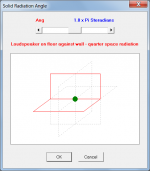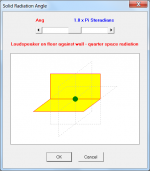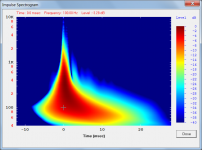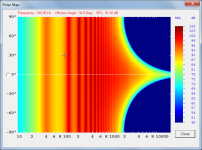@ David McBean & Sabbelbacke
Yesterday on Hornresp i clicked on Click here to download software = http://www.hardware-test.de/mcbean/Setup.exe and got the warning. I tried again just now & now i receive no warning So it's been sorted out
I realise it was a FP, but others might not have.
Yesterday on Hornresp i clicked on Click here to download software = http://www.hardware-test.de/mcbean/Setup.exe and got the warning. I tried again just now & now i receive no warning So it's been sorted out
I realise it was a FP, but others might not have.
I tried again just now & now i receive no warning So it's been sorted out
Hi Zero D,
All's well that ends well, it seems
Kind regards,
David
The Warning displayed in zero-D Screenshot is nothing coming from the website, it´s a warning message of some security instance thinking that the domain might contain something harmfull. Since the landing Page has no content at all, this is a false warning - just like sometimes a virus scanner thinks a file is infected, when it actually is not.
Hornresp Update 3240-131107
Hi Everyone,
The Radiation Angle tool boundary planes are now displayed in yellow.
I think this probably completes my "colouring in" activities for the time being .
.
At the moment, diyAudio won't allow me to upload a screenprint attachment showing the change.
Kind regards,
David
Hi Everyone,
The Radiation Angle tool boundary planes are now displayed in yellow.
I think this probably completes my "colouring in" activities for the time being
At the moment, diyAudio won't allow me to upload a screenprint attachment showing the change.
Kind regards,
David
At the moment, diyAudio won't allow me to upload a screenprint attachment showing the change.
Hi Everyone,
Things are now back to normal again!
Before and after screenprints attached.
Kind regards,
David
Attachments
With all that "coloring in". Not once did you go outside the lines.
Hi Mark,
Surprising as it may seem, "colouring in" (Aussie spelling) and "keeping inside the lines" is not a trivial exercise when Visual Basic is used to construct the graphics - which is why it took me a while to implement
Kind regards,
David
Hi Mark,
Surprising as it may seem, "colouring in" (Aussie spelling) and "keeping inside the lines" is not a trivial exercise when Visual Basic is used to construct the graphics - which is why it took me a while to implement.
Kind regards,
David
Hello David,
When personnal computers appeared in the late 70s in my lab I worked on morphological mathematics applied to the study of rocks. At the time we have to write our own routines and one that was the most problematic was the "colouring in" routine (in the first version, there was always pixels missing in the corners and as we worked on very complex contours the number of pixels that we used to estimate the area of the shape was not exact. Then with experience I did the same but in 3D to estimate volumes...
Now with most image analysis softwares we can define an area of interest (AOI) and even a polygonal aproximation and things are a lot more easier...
Best regards from Paris,
Jean-Michel Le Cléac'h
At the time we have to write our own routines and one that was the most problematic was the "colouring in" routine
Hi Jean-Michel,
Many thanks for the historical background - it is nice to know that it was not just me who had difficulty "colouring in"
(Your project was obviously a lot more complex than mine, though).
Kind regards,
David
They tongue in cheek reference to colouring in was made with a bit of understanding. Way back when I had hair, AND was programming we would have to address each pixel in the Z80 based computers I was working on. So yes I do have a foggy recollection of what kind of fun AND games this can be.
Besides, when else can I get away with teasing a man I admire and respect?
Much appreciated.
Besides, when else can I get away with teasing a man I admire and respect?
Much appreciated.
They tongue in cheek reference to colouring in was made with a bit of understanding. Way back when I had hair, AND was programming we would have to address each pixel in the Z80 based computers I was working on. So yes I do have a foggy recollection of what kind of fun AND games this can be.
Besides, when else can I get away with teasing a man I admire and respect?
Much appreciated.
Hi Mark,
I know what you mean about addressing individual pixels - what a pain it can be!
The Impulse Spectrogram and Polar Map are good examples in Hornresp.
As far as "teasing" is concerned - go for it! It's nice to have a bit of humour around the place. Life can be very boring otherwise
Kind regards,
David
Attachments
Hi, I searched this thread, and did find some mention of the term, but not sure what the current status is - I was playing around with the particle velocity tool, which is nice for checking for potential chuffing in a BR type enclosure, however for TL / TTQWT enclosures I can only view driver velocity and throat velocity. But since the narrow point for these enclosures is at the mouth, it would be nice to see mouth velocity too somehow. Any chance of this happening?
But since the narrow point for these enclosures is at the mouth, it would be nice to see mouth velocity too somehow. Any chance of this happening?
Hi James,
I will add it to the list of "things to look at"
Kind regards,
David
I will add it to the list of "things to look at". It may take a while though, as I am extremely busy at the moment.
Thanks, David! No rush of course, I'm grateful for whatever updates you manage to make in your free time.
I have another question however, I'm a bit confused by some of the numbers HornResp is giving me. I'm simulating a vented box, no real drivers, just doing some theoretical testing, here are the inputs:
Code:
ID=29.00
Ang=2.0 x Pi
Eg=45.00
Rg=0.00
Cir=0.00
S1=0.00
S2=0.00
L12=0.00
F12=0.00
S2=0.00
S3=0.00
L23=0.00
F23=0.00
S3=0.00
S4=0.00
L34=0.00
F34=0.00
S4=0.00
S5=0.00
L45=0.00
F45=0.00
Sd=1000.00
Bl=18.00
Cms=4.00E-04
Rms=4.00
Mmd=20.00
Le=1.00
Re=6.00
Nd=1
Vrc=200.00
Lrc=20.00
Ap=200.00
Lpt=42.00
Vtc=0.00
Atc=0.00
Pmax=100
Xmax=5.0
Comment=Vented Box Displacement testand I'm looking at the Acoustical Output Power (double click on spl response graph and enter a frequency). For 16Hz (this is below the port tuning frequency) the driver output has about 105dB into 2pi, which HornResp tells me is 0.2 Watts - sounds about right to me.
However when I plot the combined output, level at 16Hz goes down to about 104dB (seems reasonable, since there is going to be cancellations below tuning frequency in a vented box) - but HornResp says the acoustical output power is now 0.95Watts (ie the sum of the output power of the driver & the port at that frequency) - but shouldn't this get less if SPL is getting less?
Hi James,
The requested feature will be included in the next update - due for release in the next week or so.
I currently define the total acoustical power as the sum of the outputs from the two sources. If it makes more sense to show the resultant power after phase difference cancellations are taken into account, then that can certainly be provided instead. I would be interested in people's views on this matter.
Kind regards,
David
Thanks, David! No rush of course, I'm grateful for whatever updates you manage to make in your free time.
The requested feature will be included in the next update - due for release in the next week or so.
However when I plot the combined output, level at 16Hz goes down to about 104dB (seems reasonable, since there is going to be cancellations below tuning frequency in a vented box) - but HornResp says the acoustical output power is now 0.95Watts (ie the sum of the output power of the driver & the port at that frequency) - but shouldn't this get less if SPL is getting less?
I currently define the total acoustical power as the sum of the outputs from the two sources. If it makes more sense to show the resultant power after phase difference cancellations are taken into account, then that can certainly be provided instead. I would be interested in people's views on this matter.
Kind regards,
David
- Home
- Loudspeakers
- Subwoofers
- Hornresp




